2019-2020年高教版中职英语(基础模块 第1册)Unit 1《Nice to meet you!》word教案
- 格式:doc
- 大小:83.50 KB
- 文档页数:15
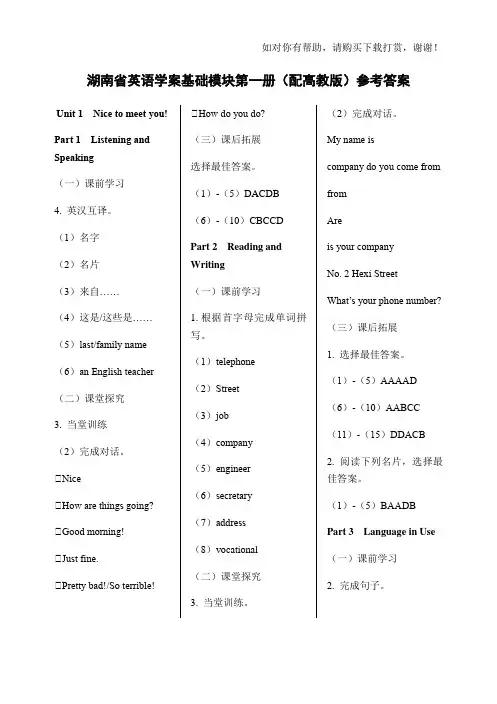
湖南省英语学案基础模块第一册(配高教版)参考答案Unit 1 Nice to meet you!Part 1 Listening and Speaking(一)课前学习4. 英汉互译。
(1)名字(2)名片(3)来自……(4)这是/这些是……(5)last/family name (6)an English teacher (二)课堂探究3. 当堂训练(2)完成对话。
①Nice②How are things going?③Good morning!④Just fine.⑤Pretty bad!/So terrible!⑥How do you do?(三)课后拓展选择最佳答案。
(1)-(5)DACDB(6)-(10)CBCCDPart 2 Reading andWriting(一)课前学习1.根据首字母完成单词拼写。
(1)telephone(2)Street(3)job(4)company(5)engineer(6)secretary(7)address(8)vocational(二)课堂探究3. 当堂训练。
(2)完成对话。
My name iscompany do you come fromfromAreis your companyNo. 2 Hexi StreetWhat’s your phone number?(三)课后拓展1. 选择最佳答案。
(1)-(5)AAAAD(6)-(10)AABCC(11)-(15)DDACB2. 阅读下列名片,选择最佳答案。
(1)-(5)BAADBPart 3 Language in Use(一)课前学习2. 完成句子。
(1)am a student(2)My father is anengineer.(3)Is(4)doctor; patients(5)Are they teachers?No, they are doctors. (二)课堂探究3. 当堂训练。
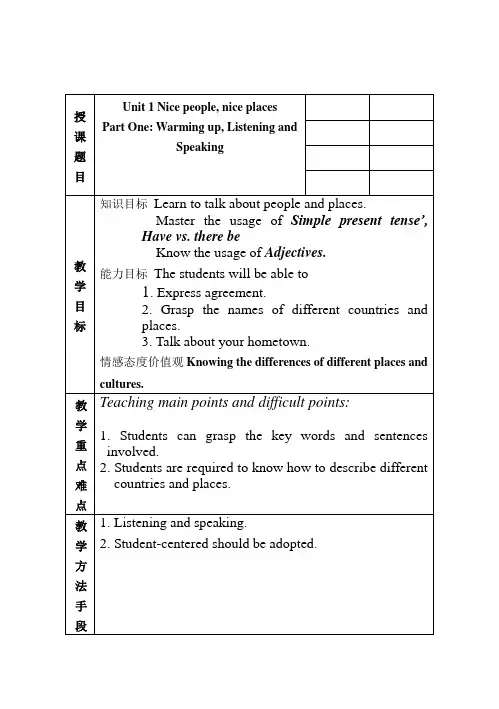
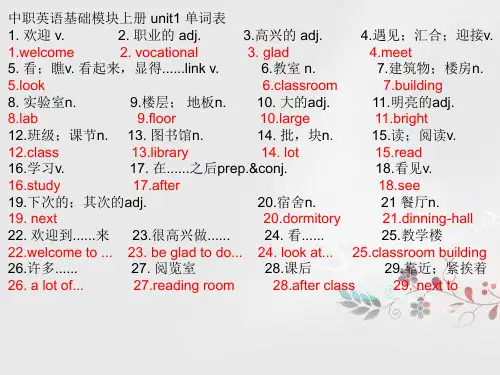

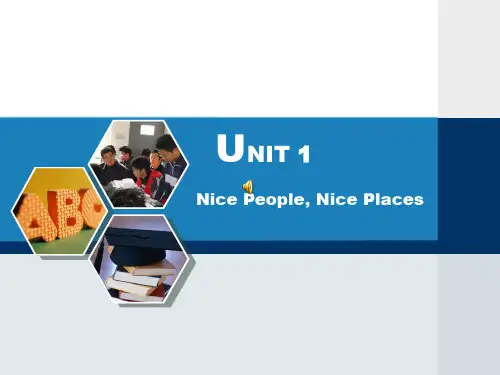

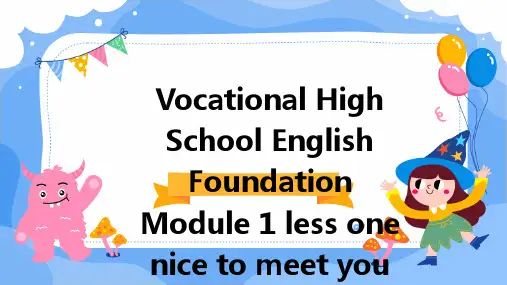
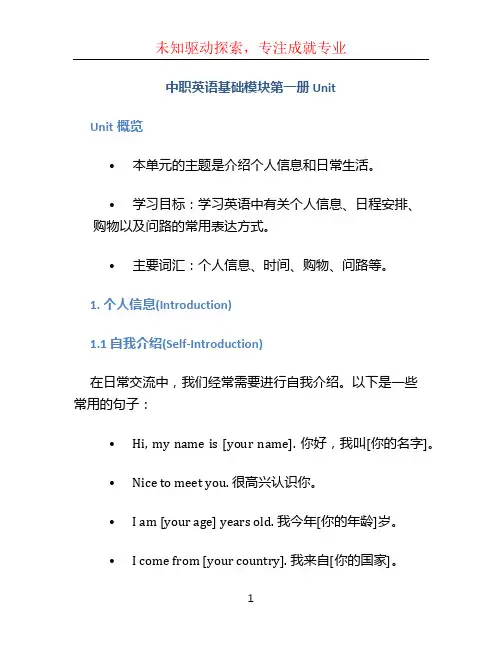
中职英语基础模块第一册 UnitUnit概览•本单元的主题是介绍个人信息和日常生活。
•学习目标:学习英语中有关个人信息、日程安排、购物以及问路的常用表达方式。
•主要词汇:个人信息、时间、购物、问路等。
1. 个人信息(Introduction)1.1 自我介绍(Self-Introduction)在日常交流中,我们经常需要进行自我介绍。
以下是一些常用的句子:•Hi, my name is [your name]. 你好,我叫[你的名字]。
•Nice to meet you. 很高兴认识你。
•I am [your age] years old. 我今年[你的年龄]岁。
•I come from [your country]. 我来自[你的国家]。
•I am a student/worker. 我是一名学生/工作者。
•My hobbies are [your hobbies]. 我的爱好是[你的爱好]。
•I can speak [languages you speak]. 我会说[你会说的语言]。
1.2 个人信息(Personal Information)在日常生活中,我们会被问到一些个人信息。
以下是一些相关表达方式:•What is your full name? 你的全名是什么?•When is your birthday? 你的生日是什么时候?•Where are you from? 你来自哪里?•What is your phone number? 你的电话号码是多少?•What is your email address? 你的邮箱地址是什么?2. 日程安排(Scheduling)2.1 询问时间(Asking for Time)在日常生活中,我们经常需要询问时间。
以下是一些常用的句子:•What time is it? 现在几点了?•Do you have the time? 请问你能告诉我时间吗?•Could you tell me the time, please? 请问你可以告诉我时间吗?2.2 时间表达(Time Expressions)在安排时间时,我们需要使用一些时间表达方式。
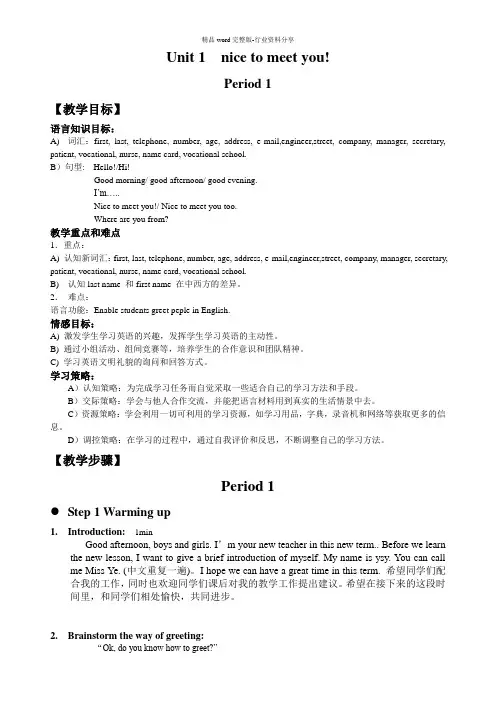
Unit 1 nice to meet you!Period 1【教学目标】语言知识目标:A) 词汇:first, last, telephone, number, age, address, e-mail,engineer,street, company, manager, secretary, patient, vocational, nurse, name card, vocational school.B)句型: Hello!/Hi!Good morning/ good afternoon/ good evening.I’m…..Nice to meet you!/ Nice to meet you too.Where are you from?教学重点和难点1.重点:A) 认知新词汇:first, last, telephone, number, age, address, e-mail,engineer,street, company, manager, secretary, patient, vocational, nurse, name card, vocational school.B) 认知last name 和first name 在中西方的差异。
2.难点:语言功能:Enable students greet peple in English.情感目标:A) 激发学生学习英语的兴趣,发挥学生学习英语的主动性。
B) 通过小组活动、组间竞赛等,培养学生的合作意识和团队精神。
C) 学习英语文明礼貌的询问和回答方式。
学习策略:A)认知策略:为完成学习任务而自觉采取一些适合自己的学习方法和手段。
B)交际策略:学会与他人合作交流,并能把语言材料用到真实的生活情景中去。
C)资源策略:学会利用一切可利用的学习资源,如学习用品,字典,录音机和网络等获取更多的信息。
D)调控策略:在学习的过程中,通过自我评价和反思,不断调整自己的学习方法。
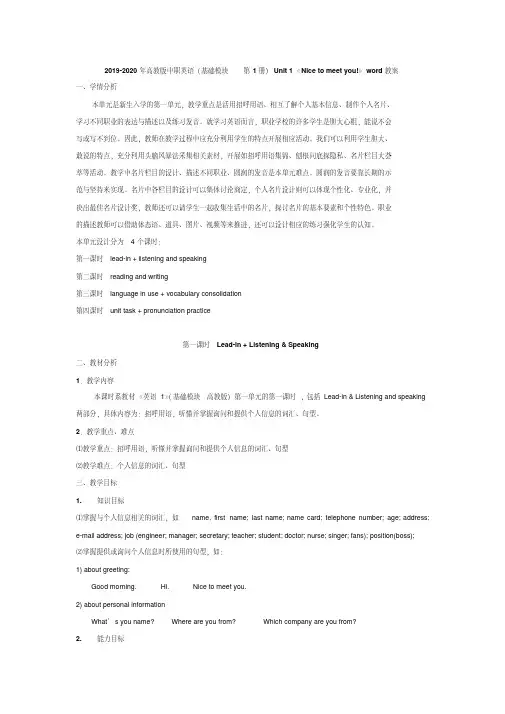
2019-2020年高教版中职英语(基础模块第1册)Unit 1《Nice to meet you!》word教案一、学情分析本单元是新生入学的第一单元,教学重点是活用招呼用语、相互了解个人基本信息、制作个人名片、学习不同职业的表达与描述以及练习发音。
就学习英语而言,职业学校的许多学生是胆大心粗,能说不会写或写不到位。
因此,教师在教学过程中应充分利用学生的特点开展相应活动。
我们可以利用学生胆大、敢说的特点,充分利用头脑风暴法采集相关素材,开展如招呼用语集锦、刨根问底探隐私、名片栏目大荟萃等活动。
教学中名片栏目的设计、描述不同职业、圆润的发音是本单元难点。
圆润的发音要靠长期的示范与坚持来实现。
名片中各栏目的设计可以集体讨论商定,个人名片设计则可以体现个性化、专业化,并决出最佳名片设计奖,教师还可以请学生一起收集生活中的名片,探讨名片的基本要素和个性特色。
职业的描述教师可以借助体态语、道具、图片、视频等来推进,还可以设计相应的练习强化学生的认知。
本单元设计分为4个课时:第一课时lead-in + listening and speaking第二课时reading and writing第三课时language in use + vocabulary consolidation第四课时unit task + pronunciation practice第一课时Lead-in + Listening & Speaking二、教材分析1.教学内容本课时系教材《英语1》(基础模块高教版)第一单元的第一课时,包括Lead-in & Listening and speaking 两部分,具体内容为:招呼用语,听懂并掌握询问和提供个人信息的词汇、句型。
2.教学重点、难点⑴教学重点:招呼用语,听懂并掌握询问和提供个人信息的词汇、句型⑵教学难点:个人信息的词汇、句型三、教学目标1.知识目标⑴掌握与个人信息相关的词汇,如name, first name; last name; name card; telephone number; age; address; e-mail address; job (engineer; manager; secretary; teacher; student; doctor; nurse; singer; fans); position(boss);⑵掌握提供或询问个人信息时所使用的句型,如:1) about greeting:Good morning. Hi. Nice to meet you.2) about personal informationWhat’s you name?Where are you from? Which company are you from?2.能力目标⑴学生能听懂关于询问和提供个人信息的对话。
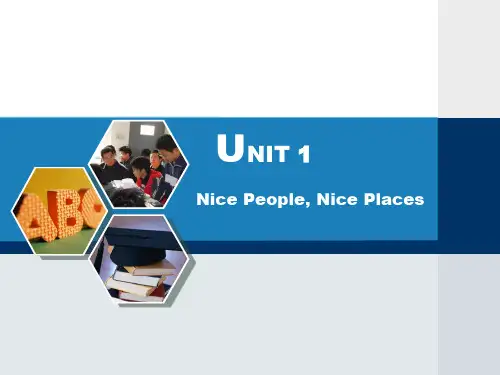
中职英语基础模块1单词表Unit 1 Greetings.1. hello [həˈləʊ] int. 喂;你好(表示问候等)2. hi [haɪ] int. 嗨;你好(非正式问候语)3. good [ɡʊd] adj. 好的;令人满意的。
4. morning [ˈmɔːnɪŋ] n. 早晨;上午。
5. afternoon [ˌɑːftəˈnuːn] n. 下午。
6. evening [ˈiːvnɪŋ] n. 晚上;傍晚。
7. how [haʊ] adv. 怎样;如何;多么。
8. are [ɑː(r)] v. 是(be的第二人称单复数现在式)9. you [juː] pron. 你;你们。
10. fine [faɪn] adj. 健康的;美好的。
11. thanks [θæŋks] n. 谢谢;感谢 int. 谢谢。
12. OK [əʊˈkeɪ] adj. 好的;不错的 int. 行;可以。
Unit 2 Introduction.1. name [neɪm] n. 名字;名称。
2. nice [naɪs] adj. 令人愉快的;美好的。
3. to [tuː] prep. 到;向;(表示接受动作的人或物)给。
4. meet [miːt] v. 遇见;相逢;结识。
5. too [tuː] adv. 也;又;太。
6. his [hɪz] pron. 他的。
7. her [hɜː(r)] pron. 她的。
8. your [jɔː(r)] pron. 你的;你们的。
Unit 3 Family.1. family [ˈfæməli] n. 家庭;家族。
2. father [ˈfɑːðə(r)] n. 父亲;爸爸。
3. mother [ˈmʌðə(r)] n. 母亲;妈妈。
4. parent [ˈpeərənt] n. 父(母)亲。
5. brother [ˈbrʌðə(r)] n. 兄弟。
2019-2020年高教版中职英语(基础模块第1册)Unit 1《Nice to meet you!》word教案一、学情分析本单元是新生入学的第一单元,教学重点是活用招呼用语、相互了解个人基本信息、制作个人名片、学习不同职业的表达与描述以及练习发音。
就学习英语而言,职业学校的许多学生是胆大心粗,能说不会写或写不到位。
因此,教师在教学过程中应充分利用学生的特点开展相应活动。
我们可以利用学生胆大、敢说的特点,充分利用头脑风暴法采集相关素材,开展如招呼用语集锦、刨根问底探隐私、名片栏目大荟萃等活动。
教学中名片栏目的设计、描述不同职业、圆润的发音是本单元难点。
圆润的发音要靠长期的示范与坚持来实现。
名片中各栏目的设计可以集体讨论商定,个人名片设计则可以体现个性化、专业化,并决出最佳名片设计奖,教师还可以请学生一起收集生活中的名片,探讨名片的基本要素和个性特色。
职业的描述教师可以借助体态语、道具、图片、视频等来推进,还可以设计相应的练习强化学生的认知。
本单元设计分为4个课时:第一课时lead-in + listening and speaking第二课时reading and writing第三课时language in use + vocabulary consolidation第四课时unit task + pronunciation practice第一课时Lead-in + Listening & Speaking二、教材分析1.教学内容本课时系教材《英语1》(基础模块高教版)第一单元的第一课时,包括Lead-in & Listening and speaking 两部分,具体内容为:招呼用语,听懂并掌握询问和提供个人信息的词汇、句型。
2.教学重点、难点⑴教学重点:招呼用语,听懂并掌握询问和提供个人信息的词汇、句型⑵教学难点:个人信息的词汇、句型三、教学目标1.知识目标⑴掌握与个人信息相关的词汇,如name, first name; last name; name card; telephone number; age; address; e-mail address; job (engineer; manager; secretary; teacher; student; doctor; nurse; singer; fans); position(boss);⑵掌握提供或询问个人信息时所使用的句型,如:1) about greeting:Good morning. Hi. Nice to meet you.2) about personal informationWhat’s you name?Where are you from? Which company are you from?2.能力目标⑴学生能听懂关于询问和提供个人信息的对话。
⑵学生能编写关于询问和提供个人信息的对话。
(3) 在日常生活中灵活应用招呼用语以及询问、提供个人信息时所用到的关键句型.3.情感目标在真实情景交流中,师生间、生生间建立融洽的关系,主动参与、相互赏识。
四、教学步骤Step One Lead-in (5m)1.The teacher greets each student: Good morning. Nice to meet you. May I have your name, please? Which school are you from? What do your parents do?(设计意图:教师熟悉班上学生,也让学生尽快彼此熟悉,在自然交流中熟悉本单元重点之一)2.Brainstorm the ways of greeting a person. Possible answers:Good morning/afternoon/evening.Hi./ Hello.Nice to meet you.How do you do?How are you?/ How are you going?(collect different answers on the blackboard)(设计意图:团队做乘法,个人做加法,通过头脑风暴,我们可以快速搜集多种招呼用语,并让全体同学尽快掌握)3.Let’s make it a rule: Let’s greet each other at the beginning of each English lesson, using the following patterns. Teacher: Class begins.The monitor: Stand up.Teacher: Good morning/afternoon, boys and girls.Students: Good morning/afternoon, teacher.Teacher: How are you today?Students: We are fine. And you?Teacher: I’m fine, too. Thank you. Sit down, please.(设计意图:固定课堂开始时的招呼问候语,问候时间适当增长,可以固定纪律,增进师生友谊)4. Activity 3. Act and practice. How would you greet a person in the following situations?(教师可以利用教材中的图片或者另外搜集不同场合的图片,让学生学会灵活应用招呼用语)Step Two Listening and speaking (22m)1.Activity 4. Listen and underline. Listen to dialogue A and underline the sentences about greeting a person.2.Practice a similar dialogue with your partner.3.Activity 8. Listen and complete. Listen to dialogue B ,and fill in the following form.4.Guess the meaning of “last name” and “first name”. (The teacher may ask some students the question: Lu Zhongnan, what’s your first name? What’s your last name?)(设计意图:教师通过询问班上多名同学的名和姓帮助学生掌握“last name”和“first name”的含义和中英文名字表达顺序的差异)5.Activity 9. Read and underline. Practice the dialogue with your partner and underline the sentences about asking one’s personal information.6.Make a similar dialogue with the classmates around you. Sample:A: Good morning! I’m Lu Zhongnan. Lu is my last name and Zhongnan is my first name. May I have your name, please?B: Good morn ing! I’m Lin Chunning. Lin is my last name and Chunning is my first name.A: Nice to meet you. I’m from No. 7 Middle school. Where are you from?B: Nice to meet you, too. I’m from No.15 Middle school.(设计意图:实际应用所学内容,俩人小组相互询问对方的名和姓,以及对方的初中学校,既操练了英语,也增进了了解)7.Ask some pairs to demonstrate their performance(greet each other and ask for personal information).(设计意图:上台展示对话,既锻炼了当事者的胆量,也让学生们快速了解彼此)8.Activity 12. Talk and complete. Talk to five classmates and ask about their first name, last name and which school they are from. And then fill in the form.(设计意图:学习利用调查、询问的方式来获取信息,确保每一位同学都知道first name 和last name的意思,增进彼此了解)Step Three Summary and Production (12m)1. Make a short summary of what we’ve learne d today.(1)key vocabulary:first name, last name, name card(2)everyday English about greetings and personal information.Hi.Good morning.How are you?How’re things?Nice to meet you.What’s your name?What’s your first name?What’s your last name?Where are you from?(设计意图:对本课时所学集体做个小结,让学生明确单元教学目标,方便学生补充笔记。
)2. Think of ten ways of greetings.Hi.Hello.How’s it going?How do you do?How are things?How are you?Haven’t seen you for ages.Great to see you again.Nice to meet you.Good morning./ Good afternoon./ Good evening.(设计意图:集思广益让学生罗列10条问候语,并请学生当堂记忆。
明确数量,可以帮助学生记忆。